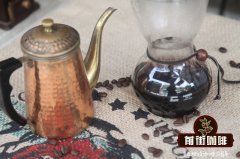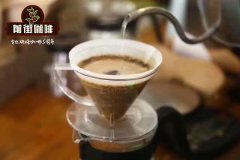Introduction to the processing process of Golden Kirin Coffee Coffee. Is Golden Kirin 70 delicious, a specialty of Bali, Indonesia?

Professional coffee knowledge exchange more coffee bean information please follow the coffee workshop (Wechat official account cafe_style)
Indonesian coffee is famous all over the world, with the second planting area and the fourth highest annual output in the world. The three big islands of Indonesia: Java, Sumatra and Sulawesi are even more important coffee producers in the world. At present, 90% of the coffee beans exported from Indonesia are Robusta beans, which are claimed to be of the highest quality in the world. The other 10 per cent is a bean called Arabica, a treasure before the discovery of Blue Mountain, and the main brand is Mandenin coffee from Sumatra.
Indonesian coffee has long been internationally famous, but many people do not know that Bali itself is also a good place to produce coffee. Bali is in a tropical monsoon climate, the annual precipitation is generally more than 1500Mel ℃, and the annual average temperature is 22Mel 25 mm, which is very suitable for coffee growth. The fertile volcanic mineral soil on the island brings the most favorable conditions for the growth of coffee beans. In addition to farming grain and vegetables, Balinese grow coffee beans and spice plants on a larger scale. Coffee cultivation techniques were introduced to Bali by the Dutch in the 17th century.
The suitable natural environment brings favorable conditions for the growth of Indonesian coffee beans:
Attracted by this blurred aroma, we came to the largest coffee factory in Bali-Golden Kirin Coffee Factory (UD.SUBUMI INTI PERKASA).
Golden Kirin Gold Coffee Factory:
Enthusiastic bosses Suryadi and Stanley have been waiting for us at the door for a long time. To our surprise, these two bespectacled young scholars do not look like businessmen running such a large-scale factory at all, but rather white-collar workers working in the company.
On the way to the plantation, the two bosses reported themselves to us: it turned out that they were both overseas Chinese in Indonesia, because they were very fond of coffee and in pursuit of a better quality of life. Jointly set up this "Golden Kirin" coffee factory in Bali in 1998.
After 10 years of careful construction, the Golden Kirin Coffee Factory has formed a self-contained production line of planting, harvesting, roasting, packaging and sales, with an annual output of nearly 100 tons of coffee beans, mainly for export.
"Golden Kirin" has a variety of coffee product lines:
According to Boss Lin, Asians' requirements for coffee are different from those in Europe. Asians don't like sour. Due to the difference between soil and sunshine in Bali, the coffee beans planted are neither astringent nor sour, bitter and sweet with fragrance. At present, coffee in Bali is mainly produced in the mountains of PUPUAN in the north of the island, which is 1000-2000 meters above sea level. Because the area is cool and foggy, it is suitable for coffee trees to grow. The average annual output of the whole island is 8000 tons. Traditional planting takes about 3-4 years from planting to harvest. Golden Kirin Coffee adopts the science and technology of cutting new branches and planting old trees, so that coffee beans can be harvested in the garden every year between July and August.
In northern Bali, where the coffee plantation is located, there is plenty of sunshine and Rain Water
When we arrived at the plantation, we saw the coffee tree. To my surprise as a layman, the fresh coffee fruit is red and tender and attractive, which is very different from the shrunken coffee beans we usually buy.
The red and attractive fruit is very different from the grayish-brown coffee beans we usually see:
Perhaps to see the confusion in my heart, Boss Lin introduced to us: "every cup of coffee needs to go through complicated procedures such as flowering, fruiting, harvesting, baking, grinding and so on." Specifically, when it comes to the coffee fruit ripening season, we will first pick it manually.
Although it takes a lot of time to pick the fruit manually, it is the key to ensuring the quality:
Then the coffee fruit will be exposed to the sun for 15 days to remove moisture. When we can hear the rattling sound when we turn the coffee fruit, it means that the fruit has been dried. At this time, we can use a sheller to remove the pulp, endocarp and silver skin of the dried fruit, and the last remaining core is what we call coffee beans.
Then, manual screening should be carried out. In order to avoid the sour smell of coffee, workers must screen out green, moth and foul-smelling coffee beans.
Select sun-dried coffee beans by manual screening:
The next step is to bake. In order to reduce the acidity and bitterness of the coffee beans, the collected coffee beans need to be placed in a strictly temperature-controlled storage room for 2 years before they can be roasted. Baking is usually baked at 350 degrees for an hour and a half, and then placed indoors to dissipate heat before the coffee beans can be packaged or ground into coffee powder for sale. " It is understood that coffee beans contain about 5% Murray 8% sugar, most of which are converted into caramel after baking, which is the source of aroma and bitterness, and the unconverted sugar leaves a little sweetness; tannin is released during baking and combines with caramel to produce a slightly bitter sweetness. Therefore, people's taste of coffee is generally bitter, sour, sweet, fragrant and astringent.
Boss Lin specially reminded that the freshly ground coffee powder had better be put on for 2 days, and then brew after the chemical change between the coffee powder and the air, the taste is better! Do not say do not know, coffee beans can also be divided into Pea berry and Flatbean. The two-petal shape of the original bean is the mother bean, and the granulated one is the male bean. In 100 kilograms of coffee beans, male beans account for only about 5 kilograms at most. As a result, the price of public beans is often about 7 times more expensive than that of mother beans.
The ball on the left is cowpea, and the flat semicircle on the right is soya bean:
It is understood that the Golden Kirin Coffee Factory adheres to strict quality management and has become a leader in the local industry. Visiting the coffee factory production process here has also become one of the favorite projects for tourists. The young boss even revealed a little secret: in their 100-acre coffee garden, they grow coffee trees with cocoa trees and vanilla, so the coffee beans here still smell like peanuts. However, it should be pointed out that Bali coffee is fine ground coffee, resulting in more coffee grounds, people who do not like too much coffee residue, it is best to use a finer filter paper filter.
"Golden Kylin" coffee beans made by multiple processes:
After visiting the coffee production process, Boss Yan enthusiastically handed us a cup of freshly brewed Golden Kirin coffee for us to taste. The first taste of the entrance, the tip of the tongue felt obvious lubrication, when the coffee juice slipped into the mouth, we were surprised, a bitter taste that no amount of sugar could cover up the mouth. Immediately this bitter taste is transformed into a charming aroma that makes people crazy and infatuated, and the taste is particularly round, thick and mellow, like thorns on the edge of flowers, making people awake and conscious. This kind of bitterness is slightly sweet and mellow, which is the unique feature of Bali coffee. There are many people who are crazy about the bitterness of Indonesia, as if they can't quit after being poisoned. If you want to know why, they will smile and tell you, "because love is made from bitterness."
END
Important Notice :
前街咖啡 FrontStreet Coffee has moved to new addredd:
FrontStreet Coffee Address: 315,Donghua East Road,GuangZhou
Tel:020 38364473
- Prev

Hand extraction Deep roasting Indonesia Sumatra Gold Manning Tiger Coffee _ how to make good Indonesian Coffee
Professional coffee knowledge exchange more coffee bean information please follow the coffee workshop (Wechat official account cafe_style) the Indonesian coffee bean selected this time is the Indonesian Sumatra gold Manning tiger, the English name is Indonisa Sumatra Tiger Mandheling. Coffee producing country: Indonesian coffee producing area: Lake Tawa (tawer lake) Coffee Variety: typica Coffee
- Next

Indonesia hand-made coffee beans recommended-how to make Mantenin coffee in Lake Toba
For more information on coffee beans, please follow the Coffee Workshop (Wechat official account cafe_style) Mantenin is produced in Indonesia's coffee producing area-the surrounding mountain area of Lake Lake Toba, which is an alpine freshwater lake located in the north of Medan, the capital of Sumatra. The average height is about 900 meters above sea level. When we say Manning, we usually mean Tuo.
Related
- Detailed explanation of Jadeite planting Land in Panamanian Jadeite Manor introduction to the grading system of Jadeite competitive bidding, Red bid, Green bid and Rose Summer
- Story of Coffee planting in Brenka region of Costa Rica Stonehenge Manor anaerobic heavy honey treatment of flavor mouth
- What's on the barrel of Blue Mountain Coffee beans?
- Can American coffee also pull flowers? How to use hot American style to pull out a good-looking pattern?
- Can you make a cold extract with coffee beans? What is the right proportion for cold-extracted coffee formula?
- Indonesian PWN Gold Mandrine Coffee Origin Features Flavor How to Chong? Mandolin coffee is American.
- A brief introduction to the flavor characteristics of Brazilian yellow bourbon coffee beans
- What is the effect of different water quality on the flavor of cold-extracted coffee? What kind of water is best for brewing coffee?
- Why do you think of Rose Summer whenever you mention Panamanian coffee?
- Introduction to the characteristics of authentic blue mountain coffee bean producing areas? What is the CIB Coffee Authority in Jamaica?

